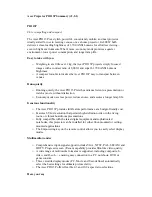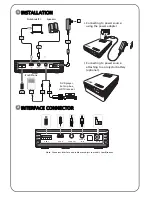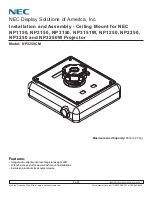
ENGLISH
–
27
Getting Started
Connection
Before starting connection
Before connection, read carefully the instruction manual for the device to be connected.
•
Turning off the power switch of the devices before connecting cables.
•
If any connection cable is not supplied with the device, or if no optional cable is available for connection of the
•
device, prepare a necessary system connection cable to suit the device.
Video signals containing too much jitter may cause the images on the screen to randomly wobble or wafture. In
•
this case, a time base corrector (TBC) must be connected.
The projector accepts the following signals: video, S-Video, analogue RGB, DVI-D and signals which are
•
compatible with the optional input module (p. 30).
Some PC models cannot be connected to the projector.
•
The pin-out and signal names of the S-VIDEO IN terminal are shown in the diagram below.
z
Outside view
Pin No.
Signal
1
Ground (luminance signal)
2
Ground (colour signal)
3
Luminance signal
4
Colour signal
The pin-out and signal names of the RGB2 IN terminal are shown in the diagram below.
z
Outside view
Pin No.
Signal
1
R/P
R
2
G/G • SYNC/Y
3
B/P
B
m
HD/SYNC
n
VD
4
,
9
,
l
,and
o
are not assigned.
5
-
8
,
j
and
k
are GND terminals.
The pin-out and signal names of the DVI-D IN terminal are shown in the diagram below.
z
x
q
p
9
8
1
Outside view
Pin No.
Signal
Pin No.
Signal
1
T.M.D.S data 2–
m
2
T.M.D.S data 2+
n
+5V
3
T.M.D.S data 2 / 4 shield
o
Ground
p
Hot plug detection
4
q
T.M.D.S data 0-
5
r
T.M.D.S data 0+
6
DDC clock
s
T.M.D.S data 0 / 5 shield
7
DDC data
8
t
9
T.M.D.S data 1–
u
j
T.M.D.S data 1+
v
T.M.D.S clock shield
k
T.M.D.S data 1 / 3 shield
w
T.M.D.S clock+
l
x
T.M.D.S clock–
















































